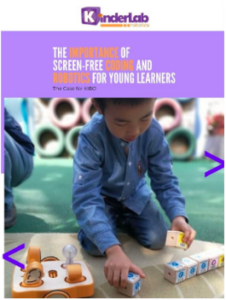District Administration: Stimulus Strides – 4 Ways Robotics Blends STEAM and SEL
In this article, Jason Innes, KinderLab’s Director of Curriculum, Training, and Product Management discusses ways robotics can take a lead role in tackling learning loss and supporting students’ well-being. All key factors in the new American Rescue Plan.
The 4 Ways include:
– Small group work that embed STEAM-oriented coding lessons into social studies, English and math.
– Decorate their robot like a storybook character and program it to act out a scene.
– While studying civil servants could, dress the robot like a firefighter or police officer and program it to drive around the map of a city.
– Prove robotics projects to help young students re-connect with each other as they return to classrooms after months of distance learning, including positive communication, collaboration and creativity skills.
The article reads in part:
Elementary school educators can use robotics—and the programming that goes with it—to energize lessons, from engineering to English language Arts, as students return to in-person learning, said Jason Innes, director of curriculum, training, and product management at KinderLab Robotics.
“We know, especially for the youngest kids, that physical manipulatives and being together in the physical space of the classroom and working directly with peers and teachers are important in early childhood education,” Innes says.
Unlike the first two stimulus packages, the recently passed American Rescue Plan provides funding beyond the immediate district needs around remote learning and connectivity. Districts can use the funds to tackle learning loss and the social-emotional setbacks students have experienced over the last year, Innes says.
“Teachers can create integrated, creative technology experiences to support core subjects that are the subject of most assessments,” Innes says.
Many of the organizations that have developed standards suggest that embedding computer science into other subjects is the best way to teach these skills, he adds.
“Students are not sitting by themselves in rows of laptops,” Innes says. “They’re working dynamically, sharing materials, learning to take turns, and developing the social-emotional skills that are as much a part of a good STEAM curriculum as the technology is.”
Read the full article.



















